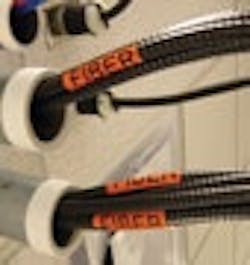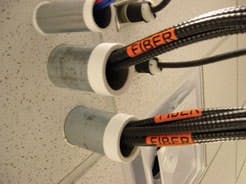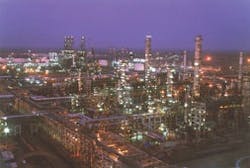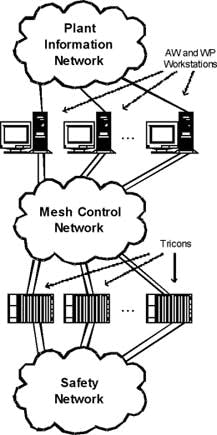More Than a Backbone
By Paul Miller, Contributing Editor
Engineers and technicians in industrial facilities and system integrators are becoming more familiar with fiberoptic networking media as a complement to or replacement for copper cabling and connectors.
A number of myths still surround the technology. Lets explore the validity of some of these myths and look at examples how optic networking technology is used to help solve problems in todays real-world industrial environments, while providing a foundation for future applications.
Myth #1Fiberoptic Cable Is Fragile
When first used in commercial applications in the late 1970s, fiber cabling was not known for its ruggedness. Cable design and construction has progressed since the early days of the technology. While improperly installed fiberoptic cable and connectors still can be more fragile than copper, this is not the case when the appropriate cable, connectors and terminations for the application are selected and the proper installation guidelines are followed.
The top reasons for choosing fiberoptic cable for use in the three Evansville Water and Sewer Utility (EWSU) treatments plants were bandwidth, EFI/EMI immunity and reliability, says Michael Halbig, president of InGen Technologies, a system engineering and process control company in Evansville, Ind., that installed extensive fiberoptic networks in the three treatment plants at the EWSU. The fiber cable delivered everything that was expected. Due to large EMI loads in the facilities, communications errors occurred from time to time when copper media was used. These can be difficult to diagnose and resolve. The fact that there have been no failures in the fiberoptic systems is proof of the reliability.
Fiber has gotten incredibly rugged, according to one of its suppliers. Ive seen someone pulling reinforced fiber cable through a conduit with a backhoe without any problems, says Sven Burkard, marketing manager at Hirschmann Americas. With fiber, you dont have the impedance losses and pair-to-pair crosstalk problems you can have with copper when non-bonded, twisted-wire pairs separate due to improper handling. Ive tied fiber into loose knots without it breaking or causing problems.
Fiber cable is pretty strong, agrees Kevin Burak, a networking consultant at Invensys Process Systems. Youd have to bend it back onto itself before youd have problems.
Myth #2Fiberoptic Networks Are More Expensive Than Copper
This might still be true at the component level, but not when you consider total installed costs. Fiberoptic cable itself often costs more per foot, but certainly not in capacity. You can push more data through fiber, says Burkard. With copper, as speeds go up, the cable tends to get more expensive. This is not usually the case with fiber.
The price of fiber has gone down to the point that the costs are about the same, says Burak. In some cases, some would argue that fiber is even cheaper, he claims. The media converters used in network switches also cost about the same.
Due to its lighter weight, smaller diameters and immunity from corrosion, fiberoptic cable often is less expensive to install and maintain than copper in many industrial applications. Fiber has really come a long way in the 10 years that Ive been in this business, says Burkard. Its no longer a voodoo-like technology relegated to the IT people. Fiber is getting very easy to implement. Once you have a properly terminated fiberoptic connection, youll have far fewer problems than with copper connections.
Myth #3Fiber Benefits Are Limited to Higher Bandwidth, Faster Speeds, Longer Distances and Interference Immunity
The obvious advantages of fiber over copper are more bandwidth, faster transmission speeds , the ability to transmit data error-free over longer distances and immunity from types of electrical interference and ground loops. However, fiber offers a number of less-obvious, but equally significant safety and security-related benefits over copper.
Since fiberoptic cable conducts light pulses rather than electricityas is the case with copper mediayou dont worry about the network causing sparks, shocks or fire, says Burak. As a result, fiber can be used in hazardous areas where copper would be problematic. Fiber also is resistant to the electromagnetic pulses (EMPs) that often follow an explosion. EMPs can cause communications problems, blanking out system screens and making it very difficult for plant operators to deal with the situation.
Fiberoptic networks are more difficult to tap into than copper networks, says Burak. With copper, all you need to do is bring a special radio close to the wire to be able to eavesdrop on a network, he says. Its also much easier for someone to physically tap into a copper network without being noticed. Any tampering of fiberoptic media will become apparent immediately to network users. As a result, fiber networks make it easier to comply with Federal Energy Regulatory Commission critical-infrastructure-protection guidelines.
Fiber is extremely secure and tamperproof, agrees Burkard. The fiber strand itself is so thin that you cant easily tap into it.
Fiberoptic cabling installed at Evansville Water and Sewer Utility plant
Initial costs might be a little higher, but Hirschmann heartily preaches the ROI-of-fiber sermon. With fiber, it doesnt matter which protocol youre transmitting, says Burkard. Be it Ethernet, Profibus, Modbus or whatever the case, the fiber cable you install today very likely will be usable 20 years from now, regardless of the protocols then in vogue. This is not likely to be the case with copper.
Obviously, the long-term benefits and virtually limitless bandwidth of fiber make it an excellent investment for the future.
Myth #4Fiberoptic Cabling Is Primarily for Backbone Communications
Heres another example of when you shouldnt believe everything you read in the textbooks. In the past, even in situations where fiber was used for inter-LAN or switch-to-switch backbone communications, copper usually connected workstations or other devices on a LAN. However, today were seeing more situations where fiberoptic networking media is used to provide high-bandwidth, high-speed, interference-free communications between workstations, controllers and other devices on real-time process control LANs.
The Reliance Jamnagar refinery and petrochemicals complex in India
Were starting to see instances where industrial sites are using switches with both copper and fiber ports, say Burkard. This lets you take the fiber right into the control panel to connect to HMIs, PLCs or other devices. You dont have the distance limitations or electrical interference problems that could be present with copper. Were also seeing more vendors offering fiberoptic ports right on their networked devices.
The new, plastic optical fiber (POF) cable promises performance similar to glass cable on short runs, at a much lower cost than single-mode glass fiber, multi-mode glass fiber or even copper cable, says Burkard. As a result, were likely to see it being used in more and more of these fiber-to-device-type applications, he adds. POF cable is much easier to work with and terminate correctly than either glass fiber or copper cable.
The EWSU has been modernizing its automation and information infrastructure in stages over the past two years. Fiberoptic LANs are used within the utilitys two wastewater treatment plants, one of which includes a full data center, and the one water filtration plant. The EWSU recently commissioned a Motorola Canopy broadband wireless network that provides an efficient communications backbone for the three plants and numerous remote locations.
InGen has primary responsibility for designing and implementing the upgraded automation and IT infrastructure for the EWSU. This includes new process control systems for the three treatment plants, where multimode fiberoptic cable has been routed throughout the plants for telemetry and SCADA purposes, according to InGens Halbig. In 2003, 2,500 ft of fiber was installed in the East Side and West Side wastewater treatment facilities, he explains. In 2007, almost 4,300 ft of fiber cable was installed in the water filtration facility.
The logical network diagram for the new Jamnagar Export Refinery under construction shows the three separate fiberoptic networks
At the water filtration plant, all fiber terminates at the main control room (Figure 2). Distributed plant controllers connect to plant servers for process control, alarming, messaging, paging, reporting and access to documents in the document management system, explains Halbig.
Fiberoptic control networks link widely distributed systems at the Jamnagar Export refinery and petrochemicals complex in India. Reliance built the worlds largest grassroots refinery at the companys manufacturing complex in the late 1990s.
This world-scale refinery and associated petrochemical complex makes extensive use of fiberoptic networks for the various automation and other systems within the complex.
The company accumulated huge amounts of domain knowledge and operational experience over the course of 10 years of efficient operation, according to Mehta. This is being used to build the new Jamnagar Export Refinery, currently under construction on an adjacent site.
To connect the various automation systems within this massive complex, Reliance is installing more than 500 km of fiberoptic cable for the DCS and ESD. An additional 250 km of fiberoptic network will be installed for other control systems.
Dedicated fiberoptic networks at the new Export Refinery will include:
- distributed control systems
- emergency shutdown system
- fire & gas control system
- process CCTV monitoring system
- PLC configuration system
- machine condition monitoring system
- analyzer management system
- compressor control systems
The Jamnagar Export Refinery DCS/ESD/PIN network is divided into three main network levels. These include the DCS mesh control network, the plant information network and the safety network. These three independent networks are not directly connected to each other. The only connections are through common non-bridging or non-forwarding devices.
The DCS mesh control network forms the core of these three networks. It is a dedicated redundant Ethernet-over-fiber network that will allow single failures to occur without affecting the overall functionality of the system. The DCS network includes servers, operator and engineering workstations and field-mounted control processors, plus VLANs to ESD systems.
The plant information network (PIN) is used for non-control, information-related activities such as data recording, printing and file transfers. It is protected and isolated from both the DCS mesh control network and the corporate LAN. The PIN is only connected to the DCS mesh control network via a third Ethernet network interface card (NIC) in DCS workstations. It is connected to the corporate LAN through a firewall.
The safety network is used for safety interlocks and time synchronization between emergency shutdown (ESD) systems. It is only connected to the mesh control network via ESD Systems.
In addition to providing the most cost-effective solution for accommodating the large distances involved at the Jamnagar complex, fiberoptics provide other site-specific benefits, including superior electrical isolation to protect equipment from ground loops as well as the often severe thunderstorms that are not uncommon in this part of the world, plus freedom from RMI and EMI interference.
Fiberoptics also provide high bandwidth to handle the large amount of communications trafficdata, voice and videothat flows over the Reliance Jamnagar plant information network today, as well as the even-higher communications rates that will be needed in the future to accommodate the planned expansions.
Lessons From the Field
Reinventing the wheel is unnecessarily time-consuming and costly. Installing fiberoptic networks doesnt need to be. Michael Halbig, president of InGen Technologies in Evansville, Ind., offers some useful tidbits from lessons hes learned.
- When choosing a cable and fiber system, multimode fiber is more tolerant than the thinner single-mode cable. Also, when considering fiberoptic cable in industrial environments, stay away from gel-filled cable that is messy and difficult to terminate.
- Fiberoptic connectors can be attached in a variety of different ways. Some are locked mechanically, some glued, and some use more of a hot melt process. Be sure to carefully evaluate each approach to decide which works best for your application and available expertise.
- Different connector manufacturers recommend different levels of fiber polishing. This can equate to additional time on the part of the contractor. When installing hundreds of connections at a site, this can add significant extra cost. Be sure to interview the contractor who will be terminating the fiber. Often, an electrical contractor will pull the cable but will subcontract another vendor to do the terminations. Be sure that the fiber termination contractor provides certified reports on each connection and guarantees the installation.




